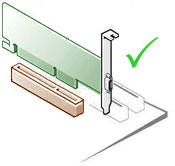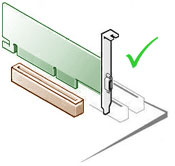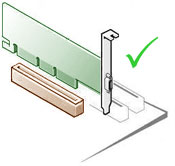Cartes vidéo
Panneau de configuration.
ou
Control.exe

c:\windows\system32\desk.cpl @0,3
ou
Paramètre -> Avancé -> Carte
Pour connaître la résolution maximum d'une carte
Windows XP
Panneau de configuration -> Affichage -> Paramètre -> Avancé -> Carte
ou
Clic droit bureau -> Paramètre -> Avancé -> Carte
Windows 7
Panneau de configuration -> Affichage -> Modifié les paramètres d'affichage -> Paramètre Avancé ->
ou
Clic droit bureau -> Résolution d'écran -> Paramètre Avancé


Control.
desk.cpl @0,3
Pilotes
Toutes les cartes vidéo depuis 1984.

Lien.
lien 1
Recherche de pilote. (inscription obligatoire)

login : litte.......... - password : a.................2
Sauvegardez lès avant formatage.
WinDriver Ghost

ver 3.0
Plus ...
Recherche de pilote rajouter l'onglet "Détail" pour trouver le bon pilote

Ouvrir les propriétés système = control.exe sysdm.cpl,System,3
Rajouter = DEVMGR_SHOW_DETAILS avec la valeur = 1

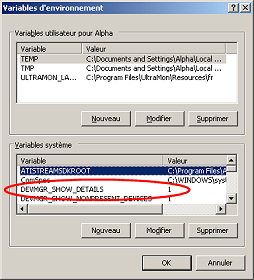
ou
 showdetail.reg
showdetail.reg
[HKEY_LOCAL_MACHINE\SYSTEM\ControlSet001\Control\Session Manager\Environment]
"DEVMGR_SHOW_DETAILS"="1"
"DEVMGR_SHOW_NONPRESENT_DEVICES"="1"
 Wikipedia
Wikipedia
1.0 - 16 février 2016
1.2 - 15-01-2020 spécifications finales - deux nouveaux pilotes AMD Radeon 20.1.2 et NVIDIA GeForce 441.99
1.3.233 - 03-11-2022
Aida 64
 Plus...
Plus...

GPU-Z

Plus...
bus PCI Express
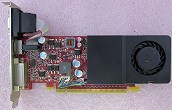
nVidia - GeForce GT 220 (12-10-2009) - (GPU GT216)
Sortie : VGA, HDMI, DVI
Mémoire : 1024Mo
PCI\VEN_10DE&DEV_0A20




Asus - EAH6570 (2012)
ASUS GeForce 7500LE 256MB DDR2 PCI Express
Chip : Redwood Pro
RAMDAC : 650MHz
Sortie : VGA, HDMI, DVI
Mémoire : 1024Mo
Puissance : 11 W
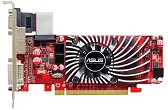



Asus - EAH5570 (2011)
ASUS GeForce 7500LE 256MB DDR2 PCI Express
Chip : Redwood Pro
RAMDAC : 400MHz
Sortie : VGA, HDMI, DVI
Mémoire : 1024Mo
Puissance : 11 W
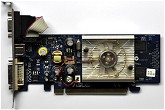



Asus - nVidia EN7500LE (2007) (LE = Lite Edition)
ASUS GeForce 7500LE 256MB DDR2 PCI Express
Chip : G72LE
RAMDAC : 400MHz
Sortie : VGA, S-Video, DVI
Mémoire : 512Mo
Puissance : 11 W
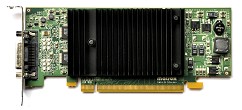



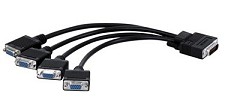 en option
en option
Matrox - Millennium P690 Plus LP PCIe x16(2007)
Sortie : LFH-60 - 2 DVI ou 4 VGA (CAB-L604XAF)
RAMDAC : 400MHz
Mémoire : 256Mo
Consommation : 11,8 W annoncé par le constructeur
Puissance : 11 W mesuré (à la louche)
Résolution max :
1 à 2 moniteurs - 1920 x 1200 (numérique)
1 à 2 moniteurs - 2048 x 1536 (analogique)
3 à 4 moniteurs - 1920 x 1200 (analogique) il faut les 4 même définition d'écran
http://pinouts.ru/VideoCables/matrox_lfh60_pinout.shtml
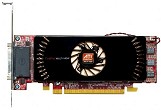
ATI - FirePro 2450 - PCIe x16
PCI\VEN_1002&DEV_95CD&SUBSYS_2B431002&REV_00\6&2A665953&0&00200008
Sortie : 2x VHDCI
RAMDAC : MHz
Mémoire : 512Mo
Consommation : 15 W annoncé par le constructeur
Puissance : 11 W mesuré (à la louche)
Résolution max : 4 moniteurs - 1920 x 1200
bus AGP Accelerated Graphics Port
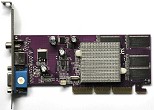




nVidia - GeForce4 MX 440 (2002)
AGP : 8x
Sortie : VGA, S-video, RCA
RAMDAC : 350MHz
Chip : NV18
Mémoire : 64Mo
Puissance : 11 W
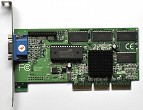




S3 - Savage4 (1999)
AGP : 4x
Sortie : VGA
RAMDAC : 300MHz
Chip : Savage4
Mémoire : 16Mo
Puissance : 6,5 W
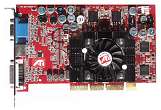



ATI - Radeon 9700 Pro (19xx)
AGP : 4x
Sortie : VGA, S-Video, DVI
RAMDAC : 400MHz
Chip : R300
Mémoire : 128Mo
Puissance : 42 W
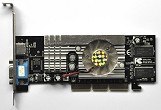




nVidia - GeForce FX 5200 (19xx)
AGP : 4x
Sortie : VGA, S-Video
RAMDAC : 350MHz
Chip : NV34
Mémoire : 128Mo
Puissance : 28,5 W
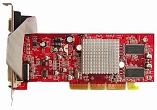




Ati - Radeon 9200 Pro (2004)
AGP : 3.0 1x, 2x, 8x
Sortie : VGA + S-video + DVI
Bios :
Chip : RV280
DAC : 400MHz
Mémoire : 128Mo
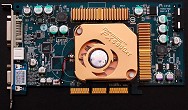



nVidia - GeForce FX 5900 XT (2003 - 200 euros)
AGP : 3.0 1x, 2x, 8x
Sortie : VGA + S-video + DVI
Chip : NV35XT
DAC : 400MHz
Mémoire : 128Mo
Puissance : 37 W
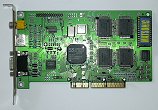
S3 - ViRGE GX2+ (19xx)
AGP : 1.0 (3,3V)
Sortie : VGA, S-video, RCA
Bios :
Chip : 86C 357
Pilote : 8A11
Mémoire : 4Mo
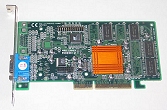
Guillemot - Phoenix 2 - Maxi Gamer
Driver
Sortie : VGA
AGP : 2x
Bios :
Chip :
Mémoire : 8Mo

Leadtek - Winfast 3D S320 (850Fr en 1999)
AGP 2.0 (3,3V - 1,5V) 1x, 2x, 4x
Sortie : VGA + S-video + Composite
Bios : 03-03-99
Chip : Riva TNT (nVidia)
Mémoire : 16Mo
640x480
800x600
1024x768
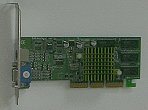
ATI - Radeon 7000 (RV 100)- 32Mo TV-OUT (2002)
Sortie : VGA + Tv-out
AGP : 4x
Bios :
Chip :
Mémoire : 32Mo
640x480 200 Hz
800x600 200 Hz
1024x768 200 Hz
1152x864 160 Hz
1280x1024 120 Hz
1600x1200 100 Hz
1920x1080 90 Hz
1920x1200 90 Hz
1920x1440 75 Hz
2048x1536 60 Hz
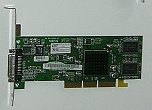



ATI - Radeon 7000 VE (2002) (Dell GX260)
AGP 2.0 (3,3V - 1,5V) 1x, 2x, 4x
Sortie : DVI (2 écrans)
Bios : 113-8110-6-1 (25-04-2002)
Chip : RV-100
DAC : 350HHz
Mémoire : 32Mo
Max :
1920x1200 - 16/10
1920x1440 - 4/3
2048x1536 - 4/3
1ère sortie 34cm x 27cm (17.1")
640x480 (4/3)
800x600 (4/3)
1152x864 (4/3)
1024x768 (16/9)
1280x1024 (4/3)
2ème sortie 31cm x 23cm (15.2")
800x600 (4/3)
1024x768 (16/9)
1ère sortie écran 21.6" 16/10
800x600 (4/3)
1024x768 (16/9)
1152x864 (4/3)
1280x768 (5/3)
1280x1024 (5/4)
1680x1050 (16/10)
1ère sortie écran 27" 16/9
800x600 (4/3)
1024x768 (16/9)
1152x864 (4/3)
1280x768 (5/3)
1280x1024 (5/4)
1400x900
1920x1080 (16/9)




Matrox - Millennium G200 AGP - Compaq (1998)
AGP : 2x
Sortie : VGA
RAMDAC : 250MHz
Chip : MGA-G200 Calao
Mémoire : 8Mo





nVidia - Geforce CG256 (1999)
AGP : 2.0 (3,3V - 1,5V) 1x, 2x, 4x
Sortie : VGA + S-video
RAMDAC : 350MHz
Chip : NV10
Mémoire : 32Mo
Puissance : 46 W
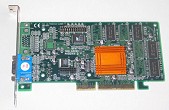




Guillemot - Maxi Gamer Phoenix 2 (1999)
(nVidia - Vanta/Vanta LT)
AGP : 2.0 (3,3V - 1,5V) 1x, 2x, 4x
Sortie : VGA
RAMDAC : 250MHz
Chip : NV5
Mémoire : 8Mo
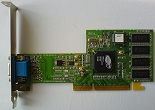




ATI - Rage XL 2X - (1999)
AGP : 2x
Mémoire : 8Mo
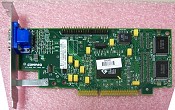




ATI - Rage Pro AGP - Compaq (1998)
AGP : 1x
Mémoire : 2Mo
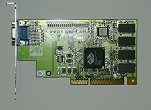
ATI 3D Rage Pro Turbo AGP (1998)
Sortie : VGA
AGP : 1.0 (3,3V) 1x, 2x
Bios :
Chip : 3D Rage Pro AGP
Mémoire : 8Mo

ATI - 3D Rage Pro AGP 2X (1997)
AGP : 2x
Sortie : VGA
Bios :
Chip : 3D Rage Pro AGP 2X
Mémoire : 4 Mo -> 8Mo (1 slots SGRAM)
1600x1200 resolution at 85 Hz
1280x1024 at 16.7 million colors
bus PCI Peripheral Component Interconnect




 en option
en option
Matrox - Parhelia-LX8 (2004)
Sortie : KX20 - 2 DVI ou 4 VGA
RAMDAC : xxxMHz
Mémoire : 128Mo
Consomation : xxx W annoncé par le constructeur
Puissance : xx W mesuré (à la louche)
Résolution max :
1600 x 1200 (20" 4/3)
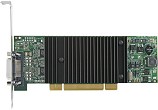



 en option
en option
Matrox - millennium P690 Plus LP PCI x16(2007)
Sortie : LFH-60 - 2 DVI ou 4 VGA (CAB-L604XAF)
RAMDAC : 400MHz
Mémoire : 256Mo
Consomation : 11,8 W annoncé par le constructeur
Puissance : 11 W mesuré (à la louche)
Résolution max :
1920 x 1200 (numérique 23,6" 16/10 ou 24" 16/9)
2048 x 1536 (analogique)
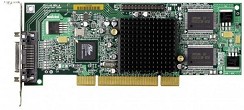



Matrox MGA G550 (2004)
Mémoire : 32Mo
Sortie : D60, 2 x DVI
Chip : xxxxx
RAMDAC : 360MHz
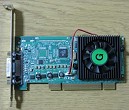



Matrox Millennium P650 Low Profil PCI (2004)
Mémoire : 64Mo
Sortie : D60, 2 x DVI
Chip : Parhelia LX
RAMDAC : 400MHz

Formac Pro Formance 40 (1997)
N'aime pas être partagé, sous XP écran noir
Bios : Imagine 128 II
Chip :
Mémoire :
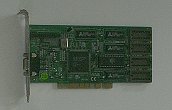
S3 Virge/DX (1997)
N'aime pas être partagé, sous XP
Bios : Atmel AT27C256
Chip : ViRGE/DX/GX (375/385)
Mémoire : (4 slots)




Matrox - Graphics Mystique 220 - (1997)
Bios :
Chip : MGA-1164SG (Cyclone) 66MHz 64bit
Pilote : Win98
RAMDAC : 220MHz
Mémoire : 4Mo SGRAM 99MHz 64bit
Puissance : 22 W
800x600 (32 bits)
1024x768 (32 bits)
1152x864 (32 bits)
1280x1024 (24 bits)
1600x1200 (16 bits)




Matrox - Graphics Mystique - (1996)
Bios :
Chip : 1064SG-D (Hurricane)
Pilote : Win98
RAMDAC : 170MHz
Mémoire : 2Mo SGRAM 99MHz 64bit
Puissance : 18 W
800x600 (32 bits)
1024x768 (16 bits)
1152x864 (16 bits)
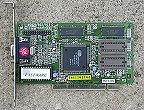
Cirrus Logic - VC921/922/923C - (199x)
Bios : Fastware
Chip : Cirrus Logic
RAMDAC :
Mémoire : (2 slots)
Pilote : Win98
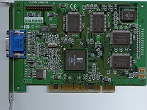
Diamond Multimedia - Diamond Stealth II S220 - (1997)
Bios :
Chip : Rendition Verite 2100
RAMDAC :
Mémoire : 4Mo SGRAM 80MHz 64bit
Pilote : NT
800x600 (32 bits)
1024x768 (32 bits)
1152x864 (16 bits) BAD
1280x1024 (16 bits) BAD sous XP
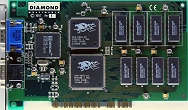
Diamond Multimedia - Monster 3D - (1997)
Bios :
Chip :
RAMDAC :
Mémoire : 4Mo EDO
Pilote : NT

Guillemot - Maxi Gamer 3D² - (1997)
Bios :
Chip :
RAMDAC :
Mémoire : 4Mo EDO
Pilote : NT
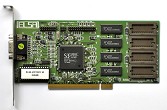



s3 - ViRGE - (1995)
Chip : 86c325
Pilote : Win98
Mémoire : 2Mo
Puissance : 17 W
bus ISA Industry Standard Architecture

Bios : Phonix
Chip : S3 86C805 (1985-1993)
Mémoire : TC514260BJL-80
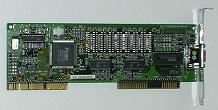
Trident Microsystems
Bios : TVGA 9200 CXr
Chip : Trident TVGA9200CXr (1993)
Mémoire : 8 slots
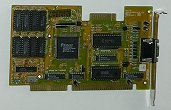
Trident Microsystems
Bios : TVGA 8900
Chip : Trident TVGA8900C (1991)
Mémoire : HY534256-70 et V53C104AP80 (8 slots)
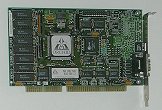
Orchid Technology Fahrenheit 1280° Plus (1993)
Bios : FAH 1280 PLUS (1990)
Chip :
Mémoire : V53C104HP45 (4 slots)
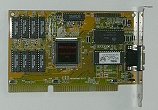
Oak Technology
Bios : Oak Technology TX2953536 (1991)
Chip : Oak
Mémoire : HY534256-70 (8 slots)
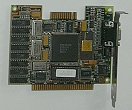
Paradise
Bios : 62-00-30-60-032 (1988)
Chip : Paradise PVGA1A
Mémoire :
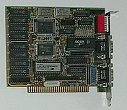
Cirrus Logic
Bios : (1988)
Chip : Cirrus Logic
Mémoire : HY53C464LS-80 (8 slots)
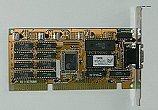
Oak Technology
Bios : Oak Technology TX2953526 (1991)
Chip : Oak
Mémoire :
Carte intégrée
Carte intégré HP 6200




Intel - HD Graphic (05-01-2011)
Chip : Sandy Bridge-DT GT1
RAMDAC : 350MHz
Sortie : VGA, DiplayPort
Mémoire : Mo
Connecteurs de sortie vidéo
 lien
lien
Analogique
Composite

VGA

S-Video

RVB

Numérique
DVI
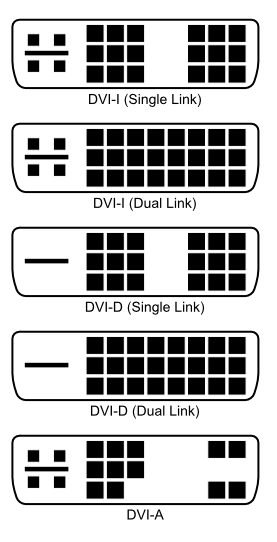
HDMI (High-Definition Multimedia Interface)

2002 = 1.0
2004 = 1.1
2005 = 1.2
Display Port

LFH-60

DMS-59

KX20

VGA = Video Graphics Array
DVI = Digital Video Interface
HDMI = High Definition Multimedia Interface
DMS = Dual Monitor Solution
LFH = Low-Force helix
AuraVision VxP524
Carte
AGP 1.0 : 3.3 V - 1x, 2x
AGP 2.0 : 1.5 V - 1x, 2x, 4x
AGP 2.0 universal : 1.5 V, 3.3 V - 1x, 2x, 4x
AGP 3.0 : 1.5 V - 4x, 8x
Port
AGP 1x - 266 Mo/s - 3,3 V
AGP 2x - 533 Mo/s - 3,3 V
AGP 4x - 1066 Mo/s - 1,5 V
AGP 8x - 2133 Mo/s (2 Go/s) -0,8V
Carte vidéo
Trident
ISA - 1 Mo
Matrox Millennium G100
AGP 4Mo
compaq 39081 G100A/4/CPQ
assy : 332887-002
spare : 328011-001
Matrox Millennium G200
AGP 8 Mo
Compaq 88124 G2+/MILA/8D/CPQ
assy : 356018-002
spare : 167033-001
ATI 3D Rage II
compaq 88094
p/n : 332836-002
spare : 332865-001
Carte vidéo
ATI Radeon 7000 (32Mo/64Mo/128Mo) AGP
Creative Labs CT6970 (32Mo) AGP Bios 2.10.02.04 (manque ventilo)
ASUS AGP-V3400TNT (16Mo) AGP 2x (NVIDIA RIVA TNT)
ATI Rage Pro Turbo (4Mo/8Mo) AGP 2x Bios 113-40214-100
Matrox Mystique PCI (4Mo/8Mo) PCI
Trident (1Mo) ISA

http://www.video-drivers.com
http://www.computerhope.com/drivers/video.htm
Pilotes Windows 98
Cirrus Logic
Cirrus Logic
Cirrus Logic 5429/30/34 PCI
Cirrus Logic 5430/40 PCI
Cirrus Logic 5434 PCI
Cirrus Logic 5436 PCI
Cirrus Logic 5446 PCI
Cirrus Logic 5462 PCI
Cirrus Logic 5464 PCI
Cirrus Logic 7542 PCI
Cirrus Logic 7543 PCI
Cirrus Logic 7548 PCI
Oak Technology
Oak Technology Super VGA
Orchid Technology
Orchid Celcius (IIT)
Orchid Fahrenheit 1280 Plus (S3)
Orchid Fahrenheit Pro 64 (S3)
Orchid Fahrenheit VA (S3)
Orchid Fahrenheit Video 3D (S3)
Orchid Kelvin 64 (Cirrus Logic)
Orchid Kelvin EZ (Cirrus Logic)
Orchid ProDesigner II (Tseng)
Paradise
Paradise Accelerator Ports O'Call (WD)
Paradise Accelerator Pro (IIT)
Paradise Accelerator VL Plus (WD)
Paradise Bahamas (S3 764/864)
Paradise Barbados 64 (S3 964)
Paradise Super VGA (WD)
S3
S3
S3 911/924
S3 928 PCI
S3 Aurora 64 V+
S3 Trio 32 PCI (732)
S3 Trio 32/64 (732/764)
S3 Trio 64 UV (767)
S3 Trio 64 V+ PCI (765)
S3 Trio 64 V2-DX/GX (775/785)
S3 ViRGE-DX/GX PCI (375/385)
S3 ViRGE-VX PCI (988)
S3 ViRGE PCI (325)
S3 Vision 864 PCI
S3 Vision 868 PCI
S3 Vision 964 PCI
S3 Vision 968 PCI
Trident Microsystems
Trident 9320 PCI
Trident 9420 PCI
Trident 9440 PCI
Trident 9685/9680/9682/9385/9385-1 PCI
Trident Super VGA
17,1" (5/3) 1024x820
(5/3) 1152x922
15,2"
24" (16/9) 1920x1200
22" (16/9) 1680x1050
19" (16/9) 1440x900
CGA : Color Graphics Adapter (620x200 en 2 couleurs ou 320x200 en 4 couleurs)
EGA : Enhanced Graphic Adaptator (640x350 en 16 couleurs)
VGA : Video Graphics Array (640x480 pixels, 16 ou 256 couleurs)
XGA : eXtended Graphics Array (1024x768 en 256 couleurs)
SVGA : Super Graphics Array
DVI : Digital Video Interactive
AGP : Accelerated Graphics Port
SGRAM : Synchronous Graphics Random Access Memory
AGP de Comment Ça Marche
AGP d'ATI
Les cartes ATI, ce n'est pas top :
Il est impossible d'installer un pilote seul, vous êtres obligé d'instaler la suite Catalyst de plusieur méga, pourquoi faire ???
Une fois que vous avez installé cette merde et que vous ave un écran de 17,1" vous ne pouvez pas toucher à la définition, donc vos ronds sont ovals = C'EST DE LA MERDE.
Sous Windows 7, c'est pire vous ne pouvez même pas changer le taux de rafraichissement, ce qui me semble être une fonction de base, même si la carte est "veille"de 4ans.


Musée Informatique Cartes Graphiques

Avec Windows XP

<- Arrière du PC
 Connecteur AGP 1,5 volts
Connecteur AGP 1,5 volts
 Connecteur AGP 3,3 volts
Connecteur AGP 3,3 volts
 Connecteur AGP universel
Connecteur AGP universel

(Source Comment ca marche)
| AGP |
Tension |
Mode |
| AGP 1.0 |
3.3 V |
1x, 2x |
| AGP 2.0 |
1.5 V |
1x, 2x, 4x |
| AGP 2.0 universal |
1.5 V, 3.3 V |
1x, 2x, 4x |
| AGP 3.0 |
1.5 V |
4x, 8x |
AGP 1.0
AGP 1.0
AGP pro
AGP 2.0 - mode 4x
AGP 3.0
AGP 1x - 1996 - 3,3V ou 1,5V
AGP 2x - 1999 - 1,5V (Intel 440 LX, EX, ZX et BX)
AGP 4x - (25W)
AGP 8x - 2003 - 0,8V - accepte les carte à 1,5V mais pas 3,3V (primière génération)
AGP pro 50 - 50W
AGP pro 110 - 110W
Info ATI Lien...
Figure 2: AGP Graphics Card Configurations
 |
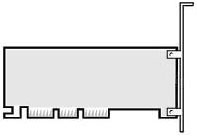 |
 |
| AGP 3.3V Graphics Card |
Universal AGP Graphics Card |
AGP 3.0 Graphics Card (1.5V, 0.8V) |
Figure 3: Supported AGP Slot/Adapter Configurations
Bus PCI express
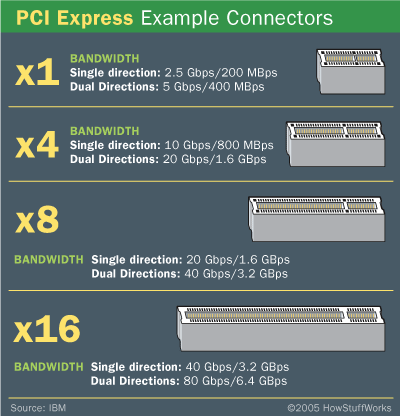

Pixel Shader
lien
Cartes graphiques compatibles et qui ont pixel shader 2.0
Séries NVIDIA GeForce (Carte pour jouer au sims 3)
FX 5900, FX 5950 (ces deux-là : avec Windows XP seulement)
6200, 6500, 6600, 6800,
7200, 7300, 7600, 7800, 7900, 7950
8400, 8500, 8600, 8800
9600, 9800, GTX 260, GTX 280
Ainsi que toutes celles dont les numéros sont compris entre deux de cette liste.
Séries ATI Radeon™ (Carte pour jouer au sims 3)
9500, 9600, 9800
X300, X600, X700, X800, X850
X1300, X1600, X1800, X1900, X1950
2400, 2600, 2900
3450, 3650, 3850, 3870,
4850, 4870
Ainsi que toutes celles dont les numéros sont compris entre deux de cette liste
"RADEON 9200 Series" = ati2mtag_RV280, PCI\VEN_1002&DEV_5C63&SUBSYS_0640148C
"RADEON 9200 Series Secondary" = ati2mtag_RV280, PCI\VEN_1002&DEV_5C43&SUBSYS_0641148C
"RADEON 9250 Series" = ati2mtag_RV280, PCI\VEN_1002&DEV_5C61&SUBSYS_0640174B
"RADEON 9250 Series - Secondary" = ati2mtag_RV280, PCI\VEN_1002&DEV_5C41&SUBSYS_0641174B
"RADEON 9200 Series " = ati2mtag_RV280, PCI\VEN_1002&DEV_5C63&SUBSYS_064017AF
"RADEON 9200 Series Secondary " = ati2mtag_RV280, PCI\VEN_1002&DEV_5C43&SUBSYS_064117AF
"RADEON 7000 SERIES" = ati2mtag_RV100, PCI\VEN_1002&DEV_5159
"RADEON 7000 Series " = ati2mtag_RV100, PCI\VEN_1002&DEV_515A
"RADEON 7200 SERIES" = ati2mtag_default, PCI\VEN_1002&DEV_5144
"RADEON 7500 SERIES" = ati2mtag_RV200, PCI\VEN_1002&DEV_5157
"RADEON 8500 SERIES" = ati2mtag_R200, PCI\VEN_1002&DEV_514C
"RADEON 8500 SERIES " = ati2mtag_R200, PCI\VEN_1002&DEV_4242
"RADEON 9000 SERIES" = ati2mtag_RV250, PCI\VEN_1002&DEV_4966
"RADEON 9000 SERIES - Secondary" = ati2mtag_RV250, PCI\VEN_1002&DEV_496E
"RADEON 9100 SERIES" = ati2mtag_R200, PCI\VEN_1002&DEV_514D
"RADEON 9200 SERIES " = ati2mtag_RV280, PCI\VEN_1002&DEV_5961 (microsoft)
"RADEON 9200 SERIES " = ati2mtag_RV280, PCI\VEN_1002&DEV_5964
"RADEON 9200 SERIES - Secondary" = ati2mtag_RV280, PCI\VEN_1002&DEV_5941 (microsoft)
"RADEON 9200 SERIES - Secondary " = ati2mtag_RV280, PCI\VEN_1002&DEV_5D44 (microsoft AGP)
"RADEON 9250" = ati2mtag_RV280, PCI\VEN_1002&DEV_5960
"RADEON 9250 - Secondary" = ati2mtag_RV280, PCI\VEN_1002&DEV_5940
"RADEON 9250/9200 SERIES" = ati2mtag_RV280, PCI\VEN_1002&DEV_5962
"RADEON 9250/9200 SERIES - Secondary" = ati2mtag_RV280, PCI\VEN_1002&DEV_5942
Carte 4 écran.
Nvidia - Quadro4 400 NVS
RAMDAC : 350MHz
RAM : 64Mo
Matrox millennium G200 MMS Quad
Carte 6 écrans.
ATI Eyefinity Radeon HD 5870
Chipset
TNT : technologie .35 micron
TNT2 : technologie .25 micron, 125/150 Mhz "TwiN Texel" 32 bits
TNT2 utra : 175 Mhz
Glossaire
GPU = Graphic Processor Unit
Home































 en option
en option


































































 en option
en option



 en option
en option





































 lien
lien













 Connecteur AGP 1,5 volts
Connecteur AGP 1,5 volts Connecteur AGP 3,3 volts
Connecteur AGP 3,3 volts Connecteur AGP universel
Connecteur AGP universel



